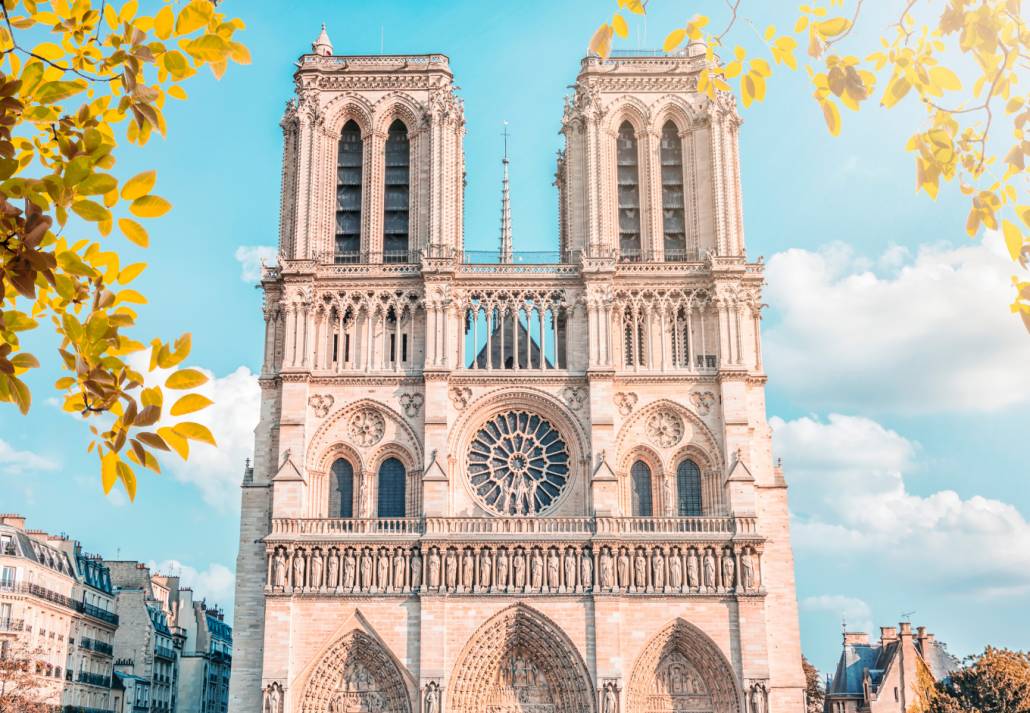On the eastern side of Île de la Cité, an island in the Seine River inside Paris, France’s 4th arrondissement, stands Notre-Dame Cathedral, also known as Notre Dame Paris (“Our Lady of Paris”) or simply Notre Dame.
The cathedral, dedicated to the Virgin Mary, is recognized as one of the best examples of French Gothic architecture.
Built in the twelfth and fourteenth centuries, Notre Dame de Paris has witnessed many battles and revolutions. Millions of people worldwide have been enthralled by the cathedral’s magnificent stained glass windows, intricate stone carvings, and towering spires, which reach over 100 meters in height.
Despite centuries of challenges, including the devastating fire in 2019, Notre Dame inspires awe and reverence among millions worldwide.
Quick Overview Of The Blog: Notre Dame Paris(Notre-Dame Cathedral): All You Need To Know
- A Brief History of The Gothic Cathedral
- Notre-Dame Cathedral: A Masterpiece Of Architectural Splendor
- Facts About Cathedral Of Notre Dame
- The Cathedral lies in a Pagan City
- Napoleon Was Crowned Emperor Here
- Victor Hugo Wrote a Book to Prevent it From Being Demolished
- FAQ
A Brief History of The Gothic Cathedral

The Notre Dame Cathedral is a Parisian icon. Situated by the lovely Seine, it is a Gothic-style masterpiece frequently ranked among the best Gothic cathedrals worldwide.
Notre Dame’s history dates back to the 12th century when construction began under King Louis VII. This Gothic masterpiece took nearly two centuries to complete, and various architects and craftsmen contributed their talents to its design and construction.
Moreover, the Cathedral suffered significant damage throughout its lengthy history, not the least of which was sustained in 1786 during the French Revolution. Thankfully, it was carefully repaired and has since drawn interest from all around the world. Even though it has hosted numerous religious rituals and historical events, people of various faiths and nations remain in awe of the Cathedral’s distinctive magnificence.
Notre-Dame Cathedral: A Masterpiece Of Architectural Splendor

One cannot help but marvel at Notre Dame’s architectural brilliance. The cathedral draws tourists worldwide with its stunning design and fascinating history, combining aspects of Gothic and Romanesque architecture.
Its magnificent façade is decorated with elaborate sculptures depicting different biblical figures or events and demonstrating the skill of the artists who created them. Three elaborate gateways surround the entry: the Portal of the Virgin, the Portal of the Last Judgment, and the Portal of Saint-Anne. Each has a special purpose and story.
What’s the most essential feature of the Cathedral? Notre Dame’s flying buttresses, a Gothic innovation, are an important architectural feature that enabled the construction of taller, more slender buildings.
Furthermore, inside, visitors can discover soaring ornate ceilings and windows with stained glass all around.
Visitors admired Notre Dame’s interior and exterior architecture (due to the 2019 fire, you can only access the crypt and view the cathedral from the outside).
Maria, a tourist, says, “The Notre Dame Cathedral has a new meaning and inspires and surprises even after the fire. Even though scaffolding covers most of the tower, the cathedral’s majestic front section remains towering, as evidence of its ongoing renovation. Notre Dame is still worth seeing, even in its most fragile state, and I can’t wait to see it in all of its splendor once more.”
Find Places To Stay In Paris, France
Facts About Cathedral Of Notre Dame
The Cathedral lies in a Pagan City

The rich history of Notre Dame Cathedral is deeply intertwined with the ancient roots of the Île-de-la-Cité, the small island in the heart of Paris upon which it stands. Long before the majestic spires of the cathedral pierced the sky, this island was home to a bustling Gallo-Roman city known as Lutetia.
Based on excavation findings, the Cathedral may have been constructed directly above the ruins of a pagan temple. An excavation beneath the choir of Notre Dame de Paris during the 1700s revealed an altar of sculptures depicting Jupiter and other gods.
Additionally, archaeological ruins dating back to this ancient era were discovered in the crypt beneath Notre Dame Square in the 1960s and ’70s.
Napoleon Was Crowned Emperor Here

Notre Dame de Paris, facing imminent demolition due to vandalism during the French Revolution, politics, and testing times, was in poor condition by the 1800s.
However, the cathedral was once again used for a magnificent celebration honoring Napoleon Bonaparte when he announced that the emperor’s coronation would occur there in 1804, giving Notre Dame a new significance that still holds today.
Victor Hugo Wrote a Book to Prevent it From Being Demolished

Notre Dame Cathedral holds immense cultural significance as one of the most iconic landmarks in Paris. It has inspired countless artists, writers, and filmmakers, including Victor Hugo, whose novel “The Hunchback of Notre Dame” in 1831 brought the cathedral to global prominence.
The restoration of the church was ordered by King Louis Philippe in 1844 after it was immediately successful.
FAQ
What is the present condition of Notre Dame Cathedral?
The 860-year-old structure is scheduled to reopen in 2024.
Can you go inside Notre Dame Paris?
Since the 2019 fire, entry to Notre Dame’s interior has been prohibited.
Why is Notre Dame so essential to France?
For almost nine centuries, it has served as a site of worship and has been the scene of multiple royal coronations, such as Napoleon Bonaparte’s crowning as Emperor of France.
Which are the top attractions in Paris?
The following are the top attractions in Paris:
Arc De Triomphe
Eiffel Tower
Louvre Paris
Musee d’Orsay
Sainte Chapelle
CuddlyNest provides all accommodations to all travelers at the best price. Find unlimited travel inspiration on our blogs and social media channels Facebook, Instagram, and Pinterest.
You May Also Like:




